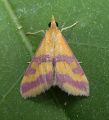2023 Annual Report for: Crambidae / Pyraustinae
For species seen in 2023 that had less than or equal to 100 records, full details are included; for more common species, the earliest, latest and highest count by vice-county are shown. The narrative for each species is taken from the main Hantsmoths website, and it is possible that some information on abundance and occurrence can get out of date, as it is impossible to keep up with all changes; however it should give a good introduction to each species. The tables in each species account summarise the previous status, and that for the current year.
For the maps, all records prior to 2023 are shown by a blue dot (the larger the dot, the more recent), with the current year's records shown in red. As previous records are superimposed on any report for 2023, new sites have greater emphasis (i.e. will show as 'more red').
In the species accounts, an asterisk next to a location indicates a new 10km square record; earliest ever dates are highlighted in orange, and latest ever in red. Initials in the species accounts refer to the recorders listed here. Please get in touch if you identify any omissions or errors, in particular if you have records that have yet to be submitted. Details of how to submit records can be found here.
63.002 [B&F: 1368] Loxostege sticticalis (Linnaeus, 1761) - Migrant
Irregular immigrant to the British Isles from southern Europe, common in some years. In Hampshire and on the Isle of Wight most frequent on the coast, but very irregular in appearance, with a notable influx in 1995 when at least 12 were recorded. Most common in the south, where it is nearly annual, reports from the north are very rare, with only four to date: one in 2022 was the first for 21 years (five individuals were reported in VC12). Wingspan 24-29 mm. Most likely to be confused with the abundant Udea olivalis, but distinguished by the characteristic white terminal streak. Larva feeds on Mugwort, over-wintering as a pupa.
Records prior to 2023
| Vice County | #Records | #Individuals | First Record | Last Record |
|---|---|---|---|---|
| 10 | 15 | 13 | 1856 | 2021 |
| 11 | 23 | 21 | 1955 | 2022 |
| 12 | 4 | 4 | 1970 | 2022 |
2023 records
| Vice County | #Records | #Individuals | Max Quantity |
|---|---|---|---|
| 11 | 3 | 3 | 1 |
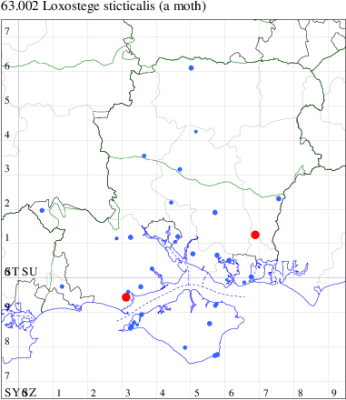
Records by year
Records by week (adult)
Records by week (larval)
Record Details
VC11: Lovedean, one, 09 Sep (ARJa); Pennington, one, 17 Jun; one, 25 Sep (RFC)
63.004 [B&F: 1364] Pyrausta sanguinalis (Linnaeus, 1767) - pRDB1
While a widespread but local species across much of the continent, in the UK populations are limited to a few colonies in sand-dunes and on limestone pavements in parts of western Ireland, northern Wales and the Isle of Man, and it is a priority species under the UK Biodiversity Action Plan. Therefore, one turning up at light in Stubbington in 2023 was probably one of the more surprising mothing events of the 21st Century, presumably relating to a primary migrant from the continent. Wingspan 14-18 mm. Somewhat variable in the brightness and contrast of the markings, but unlikely to be confused with any other British Pyrausta [Goater]. Larva feeds on Wild Thyme.
Records prior to 2023
| Vice County | #Records | #Individuals | First Record | Last Record |
|---|
2023 records
| Vice County | #Records | #Individuals | Max Quantity |
|---|---|---|---|
| 11 | 1 | 1 | 1 |
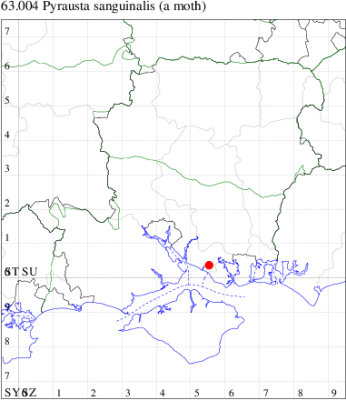
Records by year
Records by week (adult)
Records by week (larval)
Record Details
VC11: New Vice-county Record: Stubbington*, one, 16 Jun (DPH)
63.005 [B&F: 1365] Pyrausta despicata (Scopoli, 1763) - Common
Local, on sand-dunes, dry heathland, downland and open areas on chalk or limestone, throughout the British Isles. Widespread in Hampshire and Wight. Wingspan 14-19mm. Forewing more mottled and less clearly marked than in any other British Pyrausta species [Goater]. Flies both by day and night. Larva feeds on Ribwort and Greater Plantain, forming silken galleries.
Records prior to 2023
| Vice County | #Records | #Individuals | First Record | Last Record |
|---|---|---|---|---|
| 10 | 291 | 573 | 1856 | 2022 |
| 11 | 853 | 2182 | 1951 | 2022 |
| 12 | 258 | 366 | 1951 | 2022 |
2023 records
| Vice County | #Records | #Individuals | Max Quantity |
|---|---|---|---|
| 11 | 47 | 56 | 3 |
| 12 | 16 | 19 | 2 |
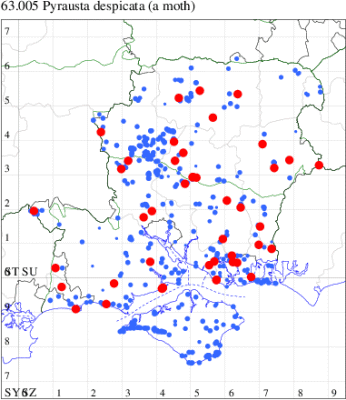
Records by year
Records by week (adult)
Records by week (larval)
Record Details
VC11: Brockwood, one, 01 Jul; one, 19 Aug (SDut); Broughton, one, 11 Jul (GCE); North Gate, NF, one, field observation, 18 Jun (TDCh); Lee, one, early record. , 28 May (CTha); North Baddesley, one, 17 Aug (RWPas); Broughton, one, 19 Jul (GCE); St Catherine's Hill NNR, Winchester, two, field observation, 27 Aug (GSD); Stubbington, one, 10 Aug (DPH); Fareham, one, 10 Aug; one, 20 Aug (ADT); Wickham, one, 02 Sep (JRDS); Portsdown, one, field observation, 22 May (RJD); Portchester, one, 05 May; three, 05 Jul; one, 11 Jul; one, 19 Aug (DH-J); Horsea Island, one, 12 May; one, 19 May; one, 21 Jul; one, 25 Aug (F.M.G.); Portsmouth, one, 04 May; one, 21 Jun; one, 22 Jun; one, 06 Jul; one, 07 Jul; one, 18 Jul; one, 21 Aug; one, 24 Aug; one, 04 Sep (IRT); Waterlooville, one, 01 Sep (DWhe); Beacon Hill nr Warnford, one, seen by day, 17 Apr (RJD); Old Winchester Hill, three, 28 Apr (F.M.G.); Havant Crematorium, one, 02 Sep (JGdr); Horndean, one, 23 Jun; one, 04 Aug (PHog); Hurn, one, 11 Jul; Hengistbury Head, two, 23 Aug (MJef); Barton on Sea, one, field observation, 24 Jun; Sway, one, 23 Aug (SKee); Needs Ore NNR, one, 09 Aug; three, 16 Aug (CNB); Warren Shore, North Solent NNR, two, field observation, 10 Aug; Needs Ore, one, field observation, 10 Aug (RAC); Browndown, one, 01 Sep; Browndown Coastal Ranges, one, 01 Sep (F.M.G.);
VC12: Cholderton, one, 04 Sep (TJN); Barton Stacey, one, 09 Jul; Littleton, one, 10 Aug; Wonston, one, 28 Aug; Cole Henley, one, 24 Aug (GCE); Magdalen Hill Down NNR, one, 07 Jul (SIng, NRJ, PPea); Morn Hill, Winchester, two, 24 Jun (CRB, PDF, DAS); North Waltham, one, 13 Jul (AJon); Tidgrove Warren,nr Overton, one, field observation, 29 Jun (ACB); Tidgrove Warren, nr Overton, two, 07 Jul (MJW, ACB); Oakridge, Basingstoke, one, 24 Aug (IFS); Alton, one, 10 Aug (DBO); Noar Hill HIWWT NR, Selborne, two, 01 Sep (AMD, FHay det. AMD); Whitehill, one, 17 Aug; one, 31 Aug (ASto); Hammer Vale, Woolmer*, one, indoors, 01 Aug (ASwa)
63.006 [B&F: 1361] Pyrausta aurata (Scopoli, 1763) - Common
Local, on chalk downland and open, grassy areas, discontinuously throughout much of England, Wales and southern Scotland. In Hampshire and on the Isle of Wight, sometimes abundant on the downs, but also in gardens amongst cultivated mint. Wingspan 15-18mm. Flies by day and night. The main confusion species is P. purpuralis which is larger and occurs less frequently in gardens. P. aurata has fewer cream spots on the forewing and the spot near the dorsal edge is either absent or small and broken into three parts. P. purpuralis has a rounded leading edge to the dorsal cream spot. Note that the purple scales apparent when freshly emerged quickly wear off and leave just a brown appearance. Larva feeds on Mint, Marjoram and Thyme, living within a silken tube or tent.
Records prior to 2023
| Vice County | #Records | #Individuals | First Record | Last Record |
|---|---|---|---|---|
| 10 | 446 | 726 | 1856 | 2022 |
| 11 | 5427 | 10962 | 1951 | 2022 |
| 12 | 2387 | 5759 | 1951 | 2022 |
2023 records
| Vice County | #Records | #Individuals | Max Quantity |
|---|---|---|---|
| 11 | 246 | 332 | 12 |
| 12 | 150 | 278 | 25 |
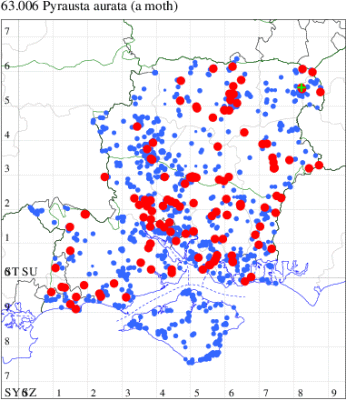
Records by year
Records by week (adult)
Records by week (larval)
Record Summary
VC11: Earliest: Wickham, 30 Apr, 1 (KdS) Latest: Marchwood, 08 Oct, 1 (CTha) Max count: Bransgore, 02 Aug, 12 (SPMC)
VC12: Earliest: Hammer Vale, Woolmer, 17 Apr, 1 (ASwa) Latest: Windmill Hill, Chalton, 11 Sep, 1 (CJP) Max count: Old Burghclere, 03 Aug, 25 (GJD)
63.007 [B&F: 1362] Pyrausta purpuralis (Linnaeus, 1758) - Common
Found on chalk downland and dry, grassy areas, throughout much of Britain favouring very short turf. In Hampshire and on the Isle of Wight, locally common on the downs, and sometimes found in gardens where Thyme is grown. Wingspan 15-22mm. Flies by day and night. At first glance, confusable with P. aurata, from which distinguished by its larger size and the rounded leading edge to the dorsal cream spot on the forewing. The hindwing always has one or two yellow spots or short, broad streaks; this is best seen by viewing the underside of the moth. Also see the very similar P. ostrinalis for differences. Note that the purple scales apparent when freshly emerged quickly wear off and leave just a brown appearance. Larva feeds on Wild Thyme and Large Thyme and sometimes Corn Mint, living within a silken tube or tent.
Records prior to 2023
| Vice County | #Records | #Individuals | First Record | Last Record |
|---|---|---|---|---|
| 10 | 161 | 444 | 1856 | 2022 |
| 11 | 1437 | 2019 | 1951 | 2022 |
| 12 | 547 | 888 | 1951 | 2022 |
2023 records
| Vice County | #Records | #Individuals | Max Quantity |
|---|---|---|---|
| 11 | 73 | 92 | 4 |
| 12 | 52 | 63 | 4 |

Records by year
Records by week (adult)
Records by week (larval)
Record Summary
VC11: Earliest: Fareham, 01 May, 1 (ADT) Latest: Dean, Bishop's Waltham, 10 Sep, 0 (CMor) Max count: Needs Ore NNR, 23 Jul, 4 (CNB)
VC12: Earliest: Windmill Hill, Chalton, 27 May, 1 (CJP) Latest: Morn Hill, Winchester, 15 Sep, 1 (CRB, PDF, DAS, LHur) Max count: Cholderton, 04 Sep, 4 (TJN)
63.009 [B&F: 1366] Pyrausta nigrata (Scopoli, 1763) - Local
Local, on chalk downland and limestone pavements, throughout much of southern England and in the Lake District. In Hampshire found locally on the downs. On the Isle of Wight, recorded only occasionally in recent years after an absence of over a century. Wingspan 14-17mm. Identified by the combination of black wings with white fringes and angled cross-lines. Larva feeds on Wild Thyme, Wild Marjoram and Corn Mint, living between leaves spun together with silk, over-wintering as a pupa
Records prior to 2023
| Vice County | #Records | #Individuals | First Record | Last Record |
|---|---|---|---|---|
| 10 | 7 | 15 | 1900 | 2007 |
| 11 | 130 | 206 | 1951 | 2022 |
| 12 | 150 | 236 | 1951 | 2022 |
2023 records
| Vice County | #Records | #Individuals | Max Quantity |
|---|---|---|---|
| 11 | 6 | 7 | 4 |
| 12 | 1 | 2 | 2 |
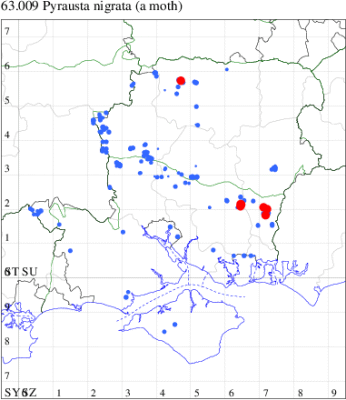
Records by year
Records by week (adult)
Records by week (larval)
Record Details
VC11: Old Winchester Hill, one, field observation, 10 Jul (RJD); Old Winchester Hill NNR, four, field observation, 29 Jul (WLan); present, field observation, 29 Jul (JHol); Oxenbourne Down, one, field observation, 15 May (AMD); Butser Hill, one, field observation, 11 May (TDCh); Queen Elizabeth CP, present, field observation, 15 May (AMD);
VC12: Old Burghclere, two, field observation, 03 Aug (GJD)
63.013 [B&F: 1387] Nascia cilialis (Hübner, 1796) - Nationally Scarce B
Nationally scarce (Nb) in marshes and fens and along freshwater margins in the Cambridgeshire fens and, very locally, in Hampshire. In Hampshire still regular in and around Titchfield Haven, with occasional wanderers elsewhere; recently found in the Afton Marsh area of the Isle of Wight and undoubtedly now resident there. Wingspan 24-27 mm. An easily recognised species, though it could conceivably be confused with the scarce immigrant Antigastra catalaunalis [Goater]. Larva feeds on Greater Pond-sedge
Records prior to 2023
| Vice County | #Records | #Individuals | First Record | Last Record |
|---|---|---|---|---|
| 10 | 14 | 20 | 2003 | 2019 |
| 11 | 43 | 114 | 1971 | 2022 |
2023 records
| Vice County | #Records | #Individuals | Max Quantity |
|---|---|---|---|
| 11 | 1 | 2 | 2 |
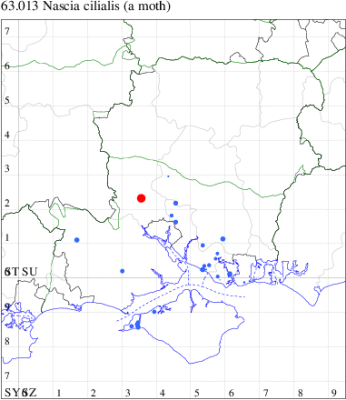
Records by year
Records by week (adult)
Records by week (larval)
Record Details
VC11: Fishlake Meadows*, two, photos available. , 15 Jun (NRJ)
63.014 [B&F: 1370] Sitochroa palealis ([Denis & Schiffermüller], 1775) - Local
Local on heathland, downland, waste ground and cliff-tops throughout much of southern England and East Anglia. In Hampshire and on the Isle of Wight an immigrant which has become established; since 1990, singletons have been seen regularly, and breeding colonies are established, perhaps temporarily, in several localities on the coast and across the chalk downland. Wingspan 29-34 mm. Fairly unmistakable: pale sulphur-yellow when fresh, fading whiter with age, but always with prominent veins. Larva feeds on flowers and seeds of Fennel, Wild Carrot, Pepper-saxifrage, Hogweed and other umbellifers.
Records prior to 2023
| Vice County | #Records | #Individuals | First Record | Last Record |
|---|---|---|---|---|
| 10 | 45 | 22 | 1856 | 2022 |
| 11 | 430 | 501 | 1949 | 2022 |
| 12 | 77 | 69 | 1951 | 2022 |
2023 records
| Vice County | #Records | #Individuals | Max Quantity |
|---|---|---|---|
| 11 | 2 | 3 | 2 |
| 12 | 1 | 1 | 1 |

Records by year
Records by week (adult)
Records by week (larval)
Record Details
VC11: Portsmouth, one, 19 Jul; two, 03 Aug (IRT);
VC12: Noar Hill HIWWT NR, Selborne, one, 11 Aug (AMD, FHay det. AMD)
63.016 [B&F: 1386] Anania fuscalis ([Denis & Schiffermüller], 1775) - Local
Local in open woodland, moorland and damp meadows throughout much of Britain. In Hampshire and on the Isle of Wight locally common on downland amongst Yellow Rattle and less so in acid woodland where the foodplant is Common Cow-wheat, and occasional elsewhere. Wingspan 20-26 mm. The most likely confusion species is Algedonia terrealis, which see for differences. Larva feeds on Yellow-rattle and Common Cow-wheat.
Records prior to 2023
| Vice County | #Records | #Individuals | First Record | Last Record |
|---|---|---|---|---|
| 10 | 33 | 58 | 1856 | 2022 |
| 11 | 180 | 260 | 1951 | 2022 |
| 12 | 173 | 2087 | 1951 | 2022 |
2023 records
| Vice County | #Records | #Individuals | Max Quantity |
|---|---|---|---|
| 11 | 2 | 3 | 2 |
| 12 | 4 | 12 | 6 |
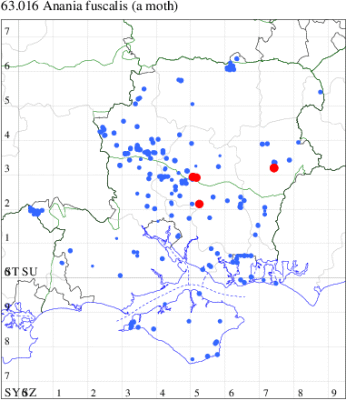
Records by year
Records by week (adult)
Records by week (larval)
Record Details
VC11: Morn Hill, Winchester, two, 10 Jun (CRB, DAS, PDF et al); Upham, one, male gen det. , 02 Jun (F.M.G. det. RJD);
VC12: Magdalen Hill Down NNR, two, 27 May (KArb, SIng, PPea, MEdg); Morn Hill, Winchester, two, 10 Jun (CRB, PDF, DAS, LHur); Noar Hill HIWWT NR, six, field observation, 23 May (DAS); Noar Hill HIWWT NR, Selborne, two, 09 Jun (AMD, FHay det. AMD)
63.017 [B&F: 1377] Anania lancealis ([Denis & Schiffermüller], 1775) - Common
Common in damp woodland and fens throughout southern England and Wales. Widely distributed and relatively common throughout Hampshire and on the Isle of Wight. Wingspan 30-34 mm. Unmistakable. Larva feeds on Hemp-agrimony, Hedge Woundwort and Greater Water-parsnip.
Records prior to 2023
| Vice County | #Records | #Individuals | First Record | Last Record |
|---|---|---|---|---|
| 10 | 287 | 659 | 1856 | 2022 |
| 11 | 552 | 551 | 1951 | 2022 |
| 12 | 288 | 515 | 1951 | 2022 |
2023 records
| Vice County | #Records | #Individuals | Max Quantity |
|---|---|---|---|
| 11 | 18 | 23 | 3 |
| 12 | 9 | 10 | 2 |

Records by year
Records by week (adult)
Records by week (larval)
Record Details
VC11: East Tytherley, two, 11 Jul (GCE); Romsey, one, 28 Jun (NRJ); Needs Ore NNR, two, 02 Jul; one, 23 Jul (PCra); Dibden Purlieu, NF, one, 13 Jun; one, 17 Aug (RAC); Allbrook, one, 11 Jul (SIng); Winchester, one, 21 Jul (THW); Dean, Bishop's Waltham, present, 19 Jun (CMor); Wickham, three, 23 Jun (F.M.G.); one, 11 Jun; one, 21 Jun; one, 11 Jul; two, 15 Jul (JRDS); Lovedean, one, 07 Jul (ARJa); Hurn, one, 18 Jun; one, 23 Jun (MJef); Bransgore, one, 25 Jun (SPMC);
VC12: Wherwell, one, 18 Jul (GCE); Anna Valley, Andover, one, 07 Jul (TJN); Grayshott, one, 07 Jul (THard); Wonston, one, 13 Jul (GCE); Rushfield Road, Liss, one, 29 Jul (KBW); Noar Hill HIWWT NR, Selborne, two, 09 Jun; one, 11 Aug (AMD, FHay det. AMD); Hammer Vale, Woolmer, one, 16 Jul (ASwa); Fleet Pond, one, 07 Jul (MHals)
63.018 [B&F: 1378] Anania coronata (Hufnagel, 1767) - Common
Common on rough ground and in gardens throughout England, Wales and Ireland. In Hampshire and on the Isle of Wight common wherever elder flourishes, and occasionally recorded away from the foodplant. Wingspan 23-26mm. The main confusion species is the far rarer P. stachydalis, which differs, for example, in the distinctly irregular distal edge of the large white spots on the hindwing and forewing — in P. coronata these white spots are neatly delineated and circular — and the slightly falcate wing-tip of P. stachydalis. Larva feeds on Elder, living within a spun or rolled leaf.
Records prior to 2023
| Vice County | #Records | #Individuals | First Record | Last Record |
|---|---|---|---|---|
| 10 | 482 | 1107 | 1856 | 2022 |
| 11 | 4472 | 6627 | 1946 | 2022 |
| 12 | 872 | 1116 | 1951 | 2022 |
2023 records
| Vice County | #Records | #Individuals | Max Quantity |
|---|---|---|---|
| 11 | 131 | 154 | 3 |
| 12 | 39 | 49 | 4 |
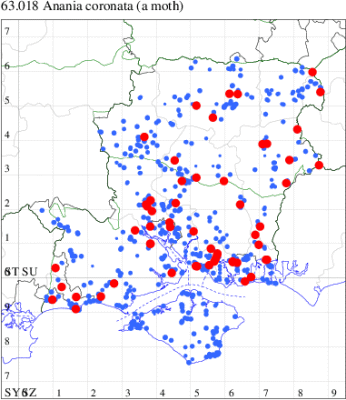
Records by year
Records by week (adult)
Records by week (larval)
Record Summary
VC11: Earliest: Romsey, 09 Jun, 1 (MJB) Latest: Swaythling, Southampton, 05 Sep, 1 (MEdg) Max count: Romsey, 18 Jun, 3 (KPea)
VC12: Earliest: Blackwater, 11 Jun, 1 (BGD) Latest: Oakridge, Basingstoke, 10 Aug, 1 (IFS) Max count: Basingstoke, 27 Jun, 4 (MJW)
63.020 [B&F: 1380] Anania perlucidalis (Hübner, [1809]) - Common
A species of fens and reed-beds, damp meadows and wasteground. In Hampshire and on the Isle of Wight, first recorded in the county in 1973, but not seen again until 1988. Since then, it has become established and is evidently spreading, though still at low density; most commonly found in the Test valley above Stockbridge, with scattered records elsewhere. Wingspan 21-23 mm. Prominent dark discal spot precludes confusion with any other species [Goater]. Larva feeds on Thistle Carduus/Cirsium.
Records prior to 2023
| Vice County | #Records | #Individuals | First Record | Last Record |
|---|---|---|---|---|
| 10 | 15 | 12 | 1981 | 2022 |
| 11 | 63 | 65 | 1981 | 2022 |
| 12 | 72 | 85 | 1981 | 2022 |
2023 records
| Vice County | #Records | #Individuals | Max Quantity |
|---|---|---|---|
| 12 | 2 | 2 | 1 |
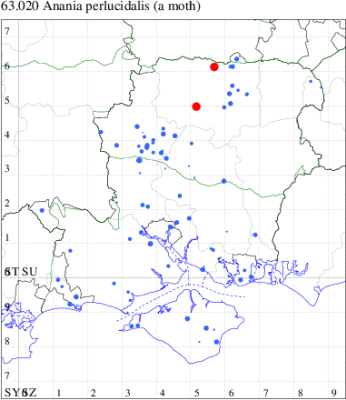
Records by year
Records by week (adult)
Records by week (larval)
Record Details
VC12: Overton, one, 14 Jun (ACr); Great Haughurst Copse, Axmansford*, one, 24 Jun (ACB)
63.022 [B&F: 1385] Anania crocealis (Hübner, 1796) - Local
Local in water meadows, marshes, river-banks and damp areas throughout much of England and Wales. The most likely confusion species is Udea lutealis, in which the cross-lines are more intricately sinuate, the stigmata are larger and clearly outlined, and there is a dark cloud in apex of hindwing [Goater]. Could also be mistaken for the extremely rare Paracorsia repandalis. Wingspan 22-25 mm. Larva feeds on Common Fleabane and Ploughman's-spikenard, living between leaves spun together with silk.
Records prior to 2023
| Vice County | #Records | #Individuals | First Record | Last Record |
|---|---|---|---|---|
| 10 | 126 | 128 | 1856 | 2022 |
| 11 | 426 | 394 | 1951 | 2022 |
| 12 | 95 | 101 | 1951 | 2022 |
2023 records
| Vice County | #Records | #Individuals | Max Quantity |
|---|---|---|---|
| 11 | 18 | 19 | 2 |
| 12 | 1 | 1 | 1 |
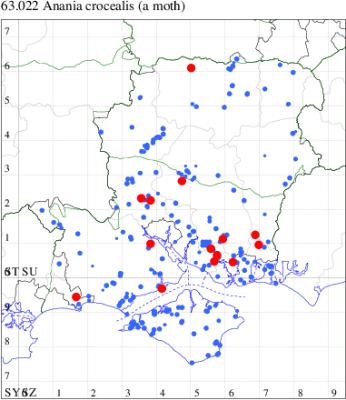
Records by year
Records by week (adult)
Records by week (larval)
Record Details
VC11: Marchwood, one, 17 Jun; one, 24 Jun (CTha); Fishlake Meadows, one, 13 Jul; Romsey, one, 07 Jul (NRJ); Winchester, one, 30 Jun; one, 07 Jul (THW); Funtley, one, 21 Jun; two, 29 Jun (TDC); Fareham, one, 28 Jun (ADT); one, 05 Sep (MLO); Dean, Bishop's Waltham, present, 19 Jun (CMor); Wickham, one, 03 Sep (JRDS); Portchester, one, 12 Aug; one, 01 Sep (DH-J); Waterlooville, one, 15 Aug; one, 01 Sep (DWhe); Lovedean, one, 24 Jun (ARJa); Burton, nr Christchurch, one, 21 Jul (JStw); Needs Ore NNR, one, 10 Jun (CNB);
VC12: Ecchinswell, one, 07 Jul (MJN)
63.023 [B&F: 1382] Anania verbascalis ([Denis & Schiffermüller], 1775) - Nationally Scarce B
Nationally scarce (Nb) in open areas where the foodplant grows, such as heaths and shingle beaches, in parts of southern England. In Hampshire and on the Isle of Wight chiefly confined to the New Forest and the coast, and distinctly uncommon in northern Hampshire. Wingspan 22-26 mm. The species has a characteristic bronze coloration which readily distinguishes it [Goater]. Larva feeds on Wood Sage.
Records prior to 2023
| Vice County | #Records | #Individuals | First Record | Last Record |
|---|---|---|---|---|
| 10 | 9 | 8 | 1856 | 2022 |
| 11 | 95 | 84 | 1907 | 2022 |
| 12 | 3 | 1 | 1951 | 2003 |
2023 records
| Vice County | #Records | #Individuals | Max Quantity |
|---|---|---|---|
| 11 | 2 | 1 | 1 |
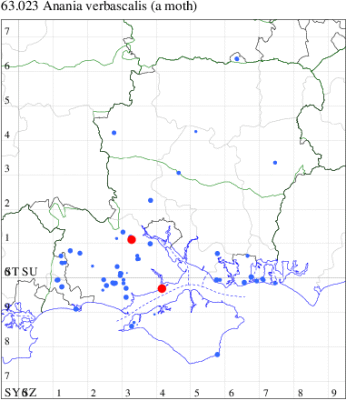
Records by year
Records by week (adult)
Records by week (larval)
Record Details
VC11: Woodlands, NF, present, 07 Jul (CyJon); Needs Ore NNR*, one, 16 Jun (CNB)
63.025 [B&F: 1376] Small Magpie Anania hortulata (Linnaeus, 1758) - Common
Common wherever there are nettles, throughout southern England and locally in northern England and southern Scotland. Widespread and common in Hampshire and on the Isle of Wight. Wingspan 33-35 mm. One of the most distinctive and easily recognised British species of micro-moth. Larva feeds on both perennial and annual species of nettle, Stinging Nettle and Small Nettle.
Records prior to 2023
| Vice County | #Records | #Individuals | First Record | Last Record |
|---|---|---|---|---|
| 10 | 1092 | 2625 | 1951 | 2022 |
| 11 | 7337 | 11292 | 1951 | 2022 |
| 12 | 3597 | 7325 | 1951 | 2022 |
2023 records
| Vice County | #Records | #Individuals | Max Quantity |
|---|---|---|---|
| 11 | 238 | 303 | 6 |
| 12 | 152 | 232 | 12 |
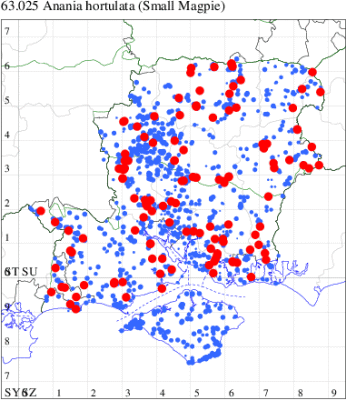
Records by year
Records by week (adult)
Records by week (larval)
Record Summary
VC11: Earliest: Wickham, 21 May, 1 (DdS) Latest: Portchester, 21 Aug, 1 (CEH, JGS) Max count: Winchester, 30 Jun, 6 (THW)
VC12: Earliest: Hawk Conservancy Trust, Weyhill, 03 May, 0 (iNat) Latest: Chawton, 03 Aug, 1 (DAS) Max count: Overton, 09 Jun, 12 (ACr)
63.028 [B&F: 1375] European Corn-borer Ostrinia nubilalis (Hübner, 1796) - Local
Local on waste ground in south-east England, formerly a rare immigrant, subsequently becoming established in the Thames Valley and around Portsmouth, and now found throughout much of southern England. Widespread and fairly common in Hampshire and on the Isle of Wight. Wingspan 29-37 mm. Male is unmistakable; female can be confused with Sitochroa verticalis, but in that species the second line on forewing is evenly curved, not angled below half-way. Larva feeds in Britain on Mugwort, on the continent it is often a serious pest of Maize.
Records prior to 2023
| Vice County | #Records | #Individuals | First Record | Last Record |
|---|---|---|---|---|
| 10 | 317 | 520 | 1850 | 2022 |
| 11 | 2249 | 3086 | 1951 | 2022 |
| 12 | 558 | 918 | 1951 | 2022 |
2023 records
| Vice County | #Records | #Individuals | Max Quantity |
|---|---|---|---|
| 11 | 199 | 325 | 11 |
| 12 | 81 | 158 | 9 |
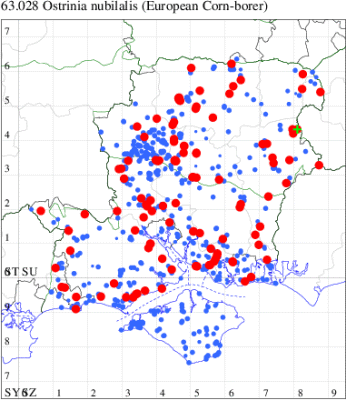
Records by year
Records by week (adult)
Records by week (larval)
Record Summary
VC11: Earliest: Marchwood, 09 Jun, 1 (CTha) Latest: Dean, Bishop's Waltham, 17 Sep, 0 (CMor) Max count: Brockwood, 07 Jul, 11 (SDut)
VC12: Earliest: Blacknest, Binstead, 09 Jun, 1 (MAng) Latest: Cheriton, 24 Sep, 1 (DAS) Max count: Basingstoke, 27 Jul, 9 (MJW)
